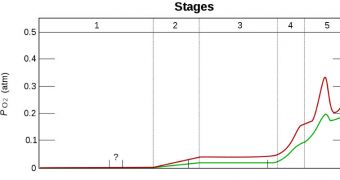It is widely believed in the international scientific community that the oxygenation event that took place some 400 million years ago played a large role in the development of life as we know it.
This event is different from the Great Oxygenation Event, which took place some 2.4 billion years ago, and saw the first traces of the gas being released into the atmosphere.
The more recent oxygenation took place at the same time when large predatory fish and vascular plants appeared. Researchers do not believe that this was a coincidence, according to a new study.
Allowing for oxygen gas to accumulate in the planet's oceans and atmosphere was a very complex process. It may have its roots billions of years ago, but its only some 500 million years ago that O2 started to really accumulate in the air.
This has always begged the question for paleontologists and anthropologists as to what type of oxygen environment were the most ancient creatures in the seas and on land subjected to.
“There has been a lot of speculation over the years about whether or not oxygen in the atmosphere was steady or variable over the last 500 million years,” says Ariel Anbar.
“This is the era during which animals and land plants emerged and flourished. So it’s a profound question in understanding the history of life,” adds the experts, who is based at the Arizona State University (ASU).
“These new findings not only suggest that oxygen levels varied, but also that the variation had direct consequences for the evolution of complex life,” says Anbar, the leader of the Astrobiology Program at the university.
He is also a professor in the Department of Chemistry and Biochemistry, and in the School of Earth and Space Exploration, at the College of Liberal Arts and Sciences.
Basically, what the new work does is explore how global oxygen levels changed during a time called the Phanerozoic, which is Greek for “evident animals.”
“Early animals evolved in an environment with less oxygen than today,” Anbar reveals. The study was led by former Harvard postdoctoral student, Tais W. Dahl.
Additionally, it was revealed that “co-evolution” is real phenomenon. While it is true that oxygen levels influenced the development of species, the opposite is also true.
The development of vascular plants around 400 million years ago caused a drop in global levels of carbon dioxide. This means that oxygen levels grew again after the Great Oxidation Event.
Funds for the new work came from the Danish National Research Foundation, the Danish Council for Independent Research, the Swedish Research Council, the NASA Astrobiology Institute team at ASU, and the NASA Exobiology Program.

 14 DAY TRIAL //
14 DAY TRIAL //